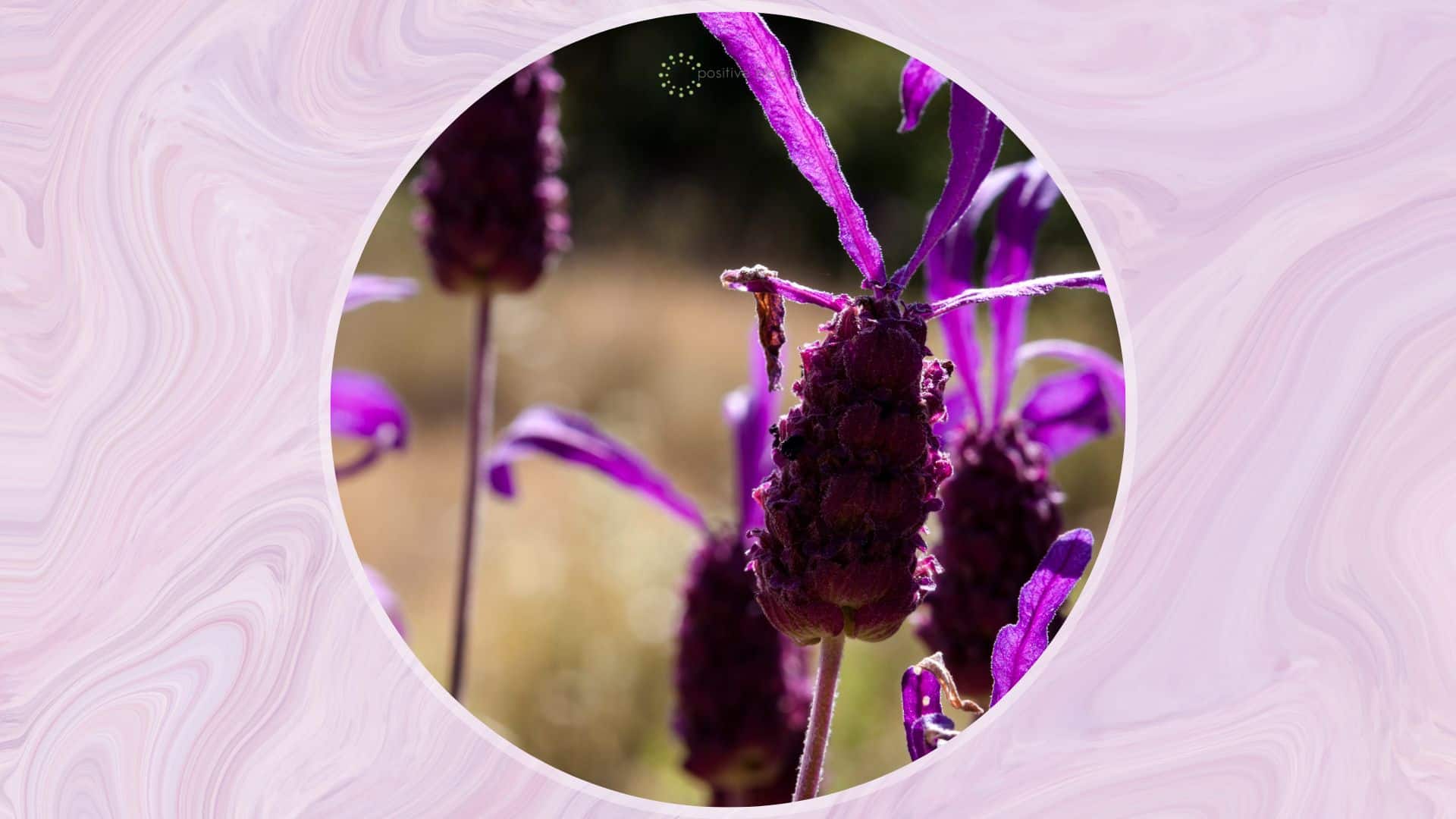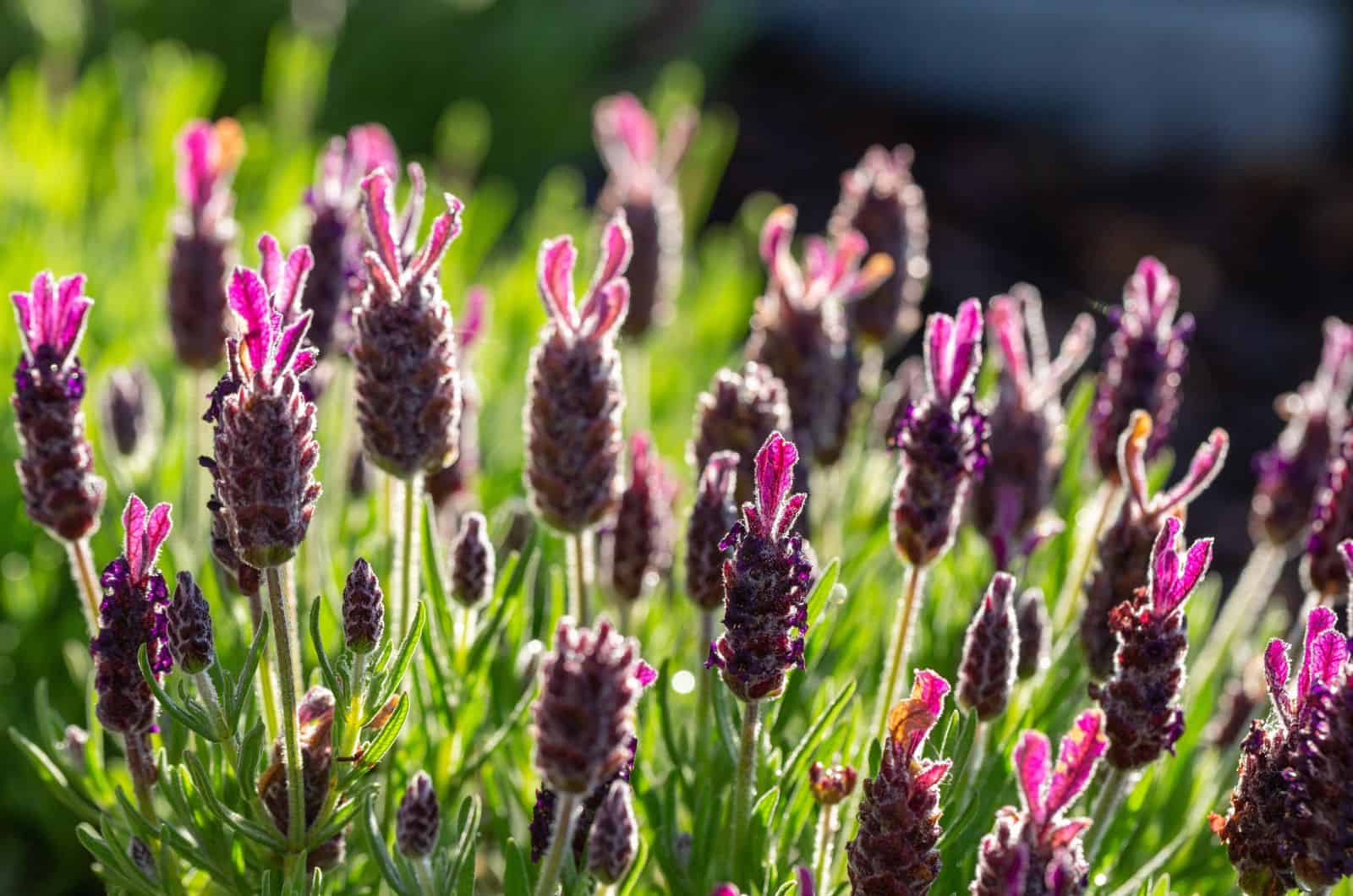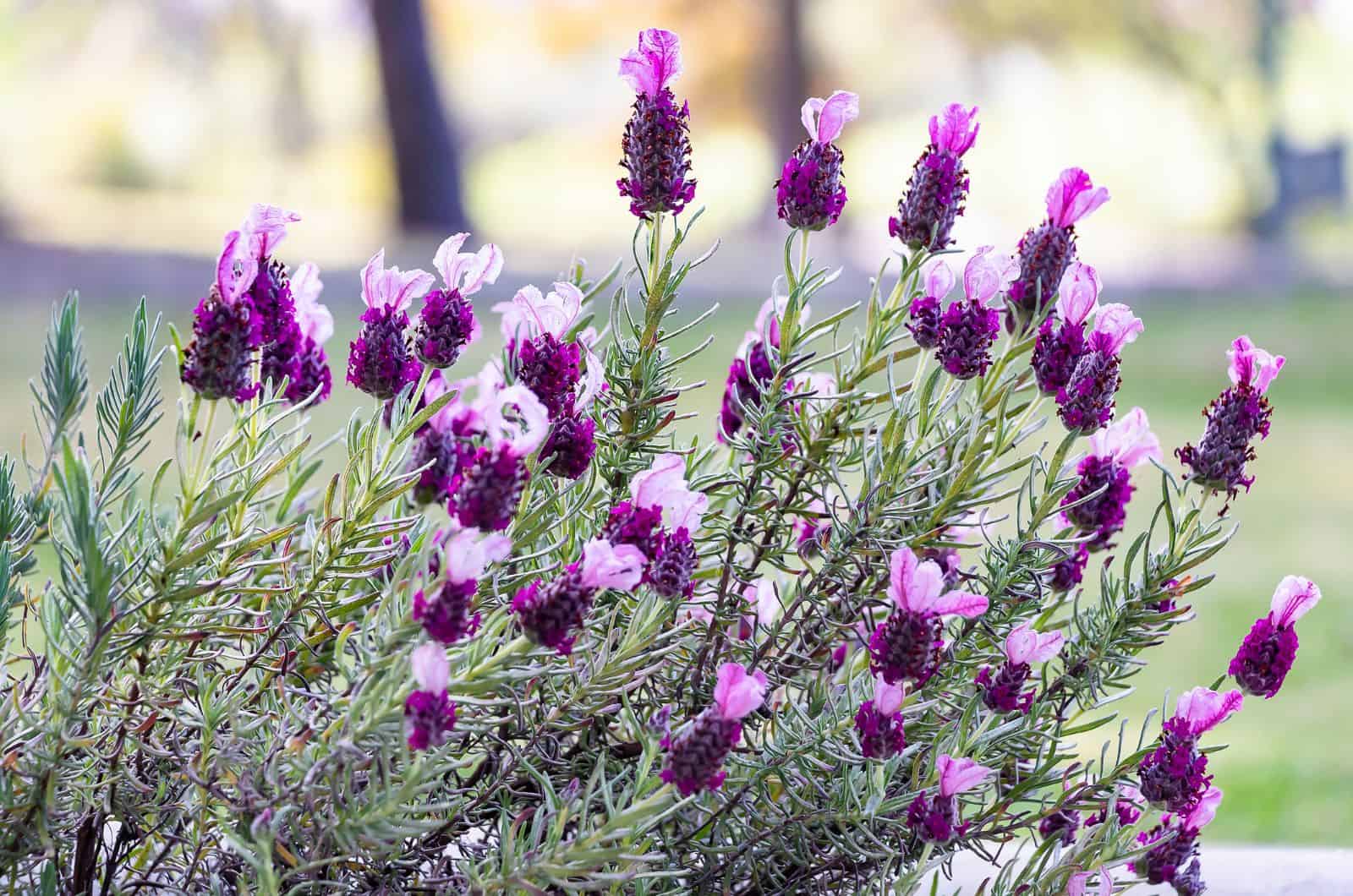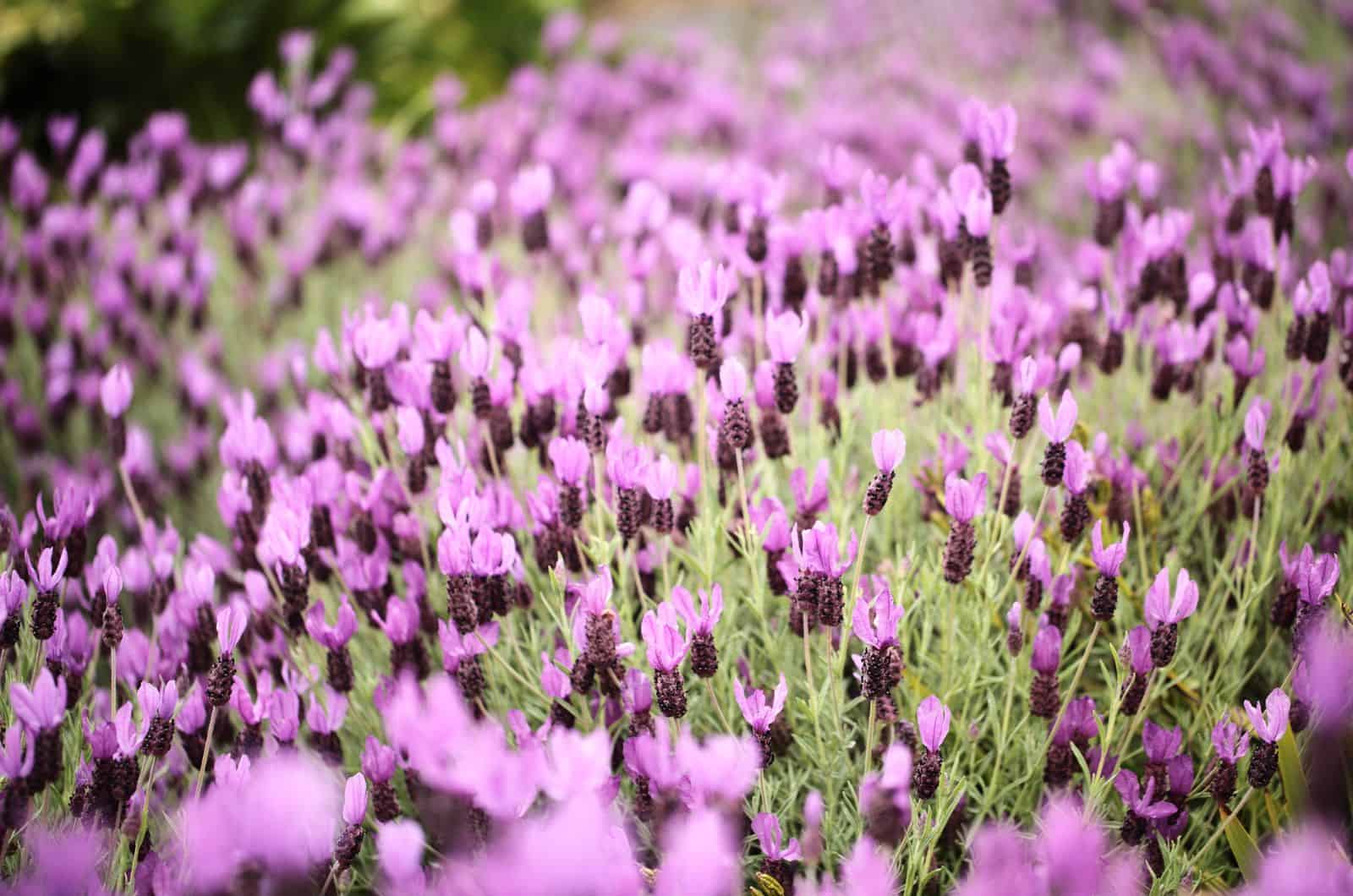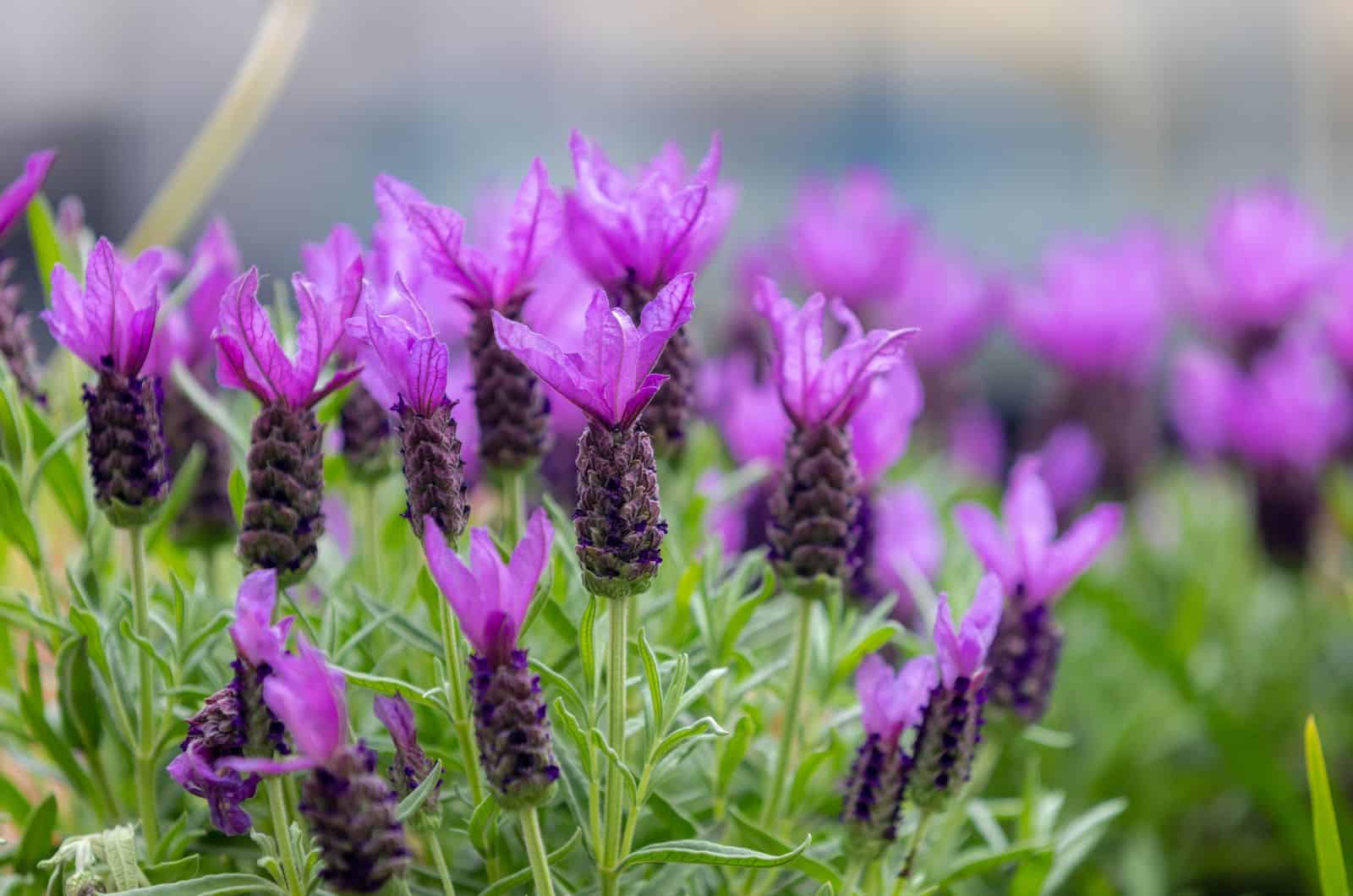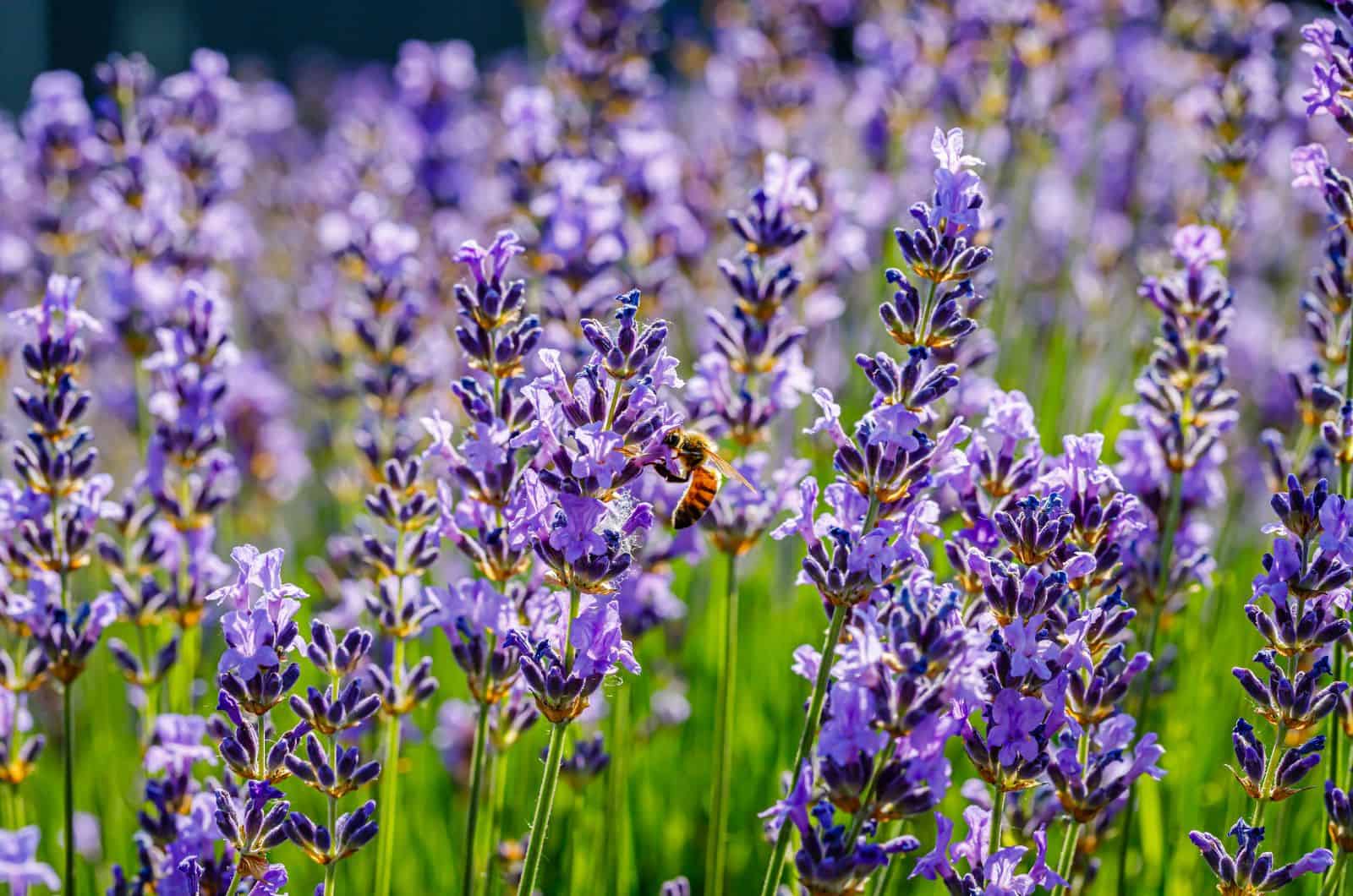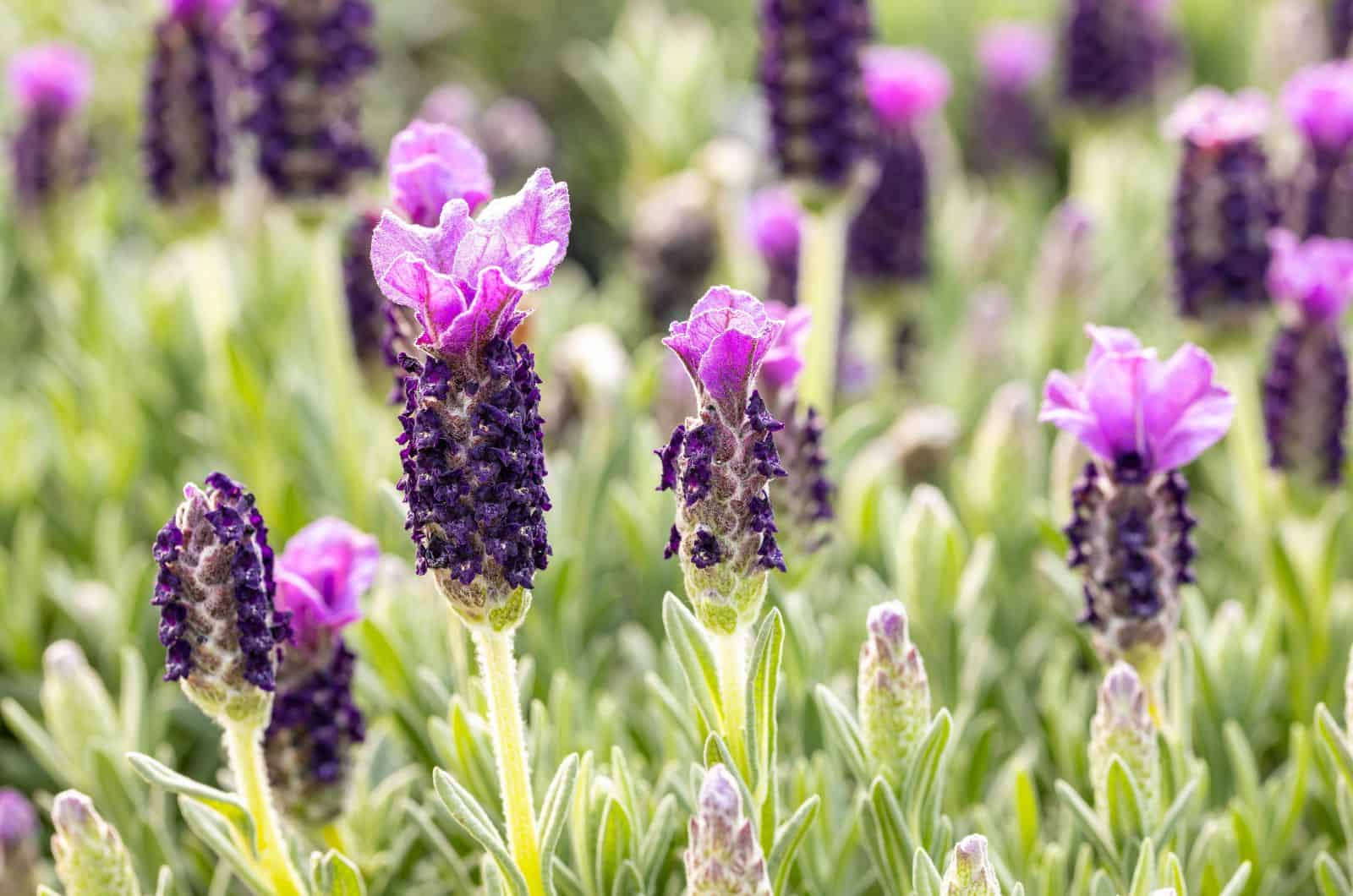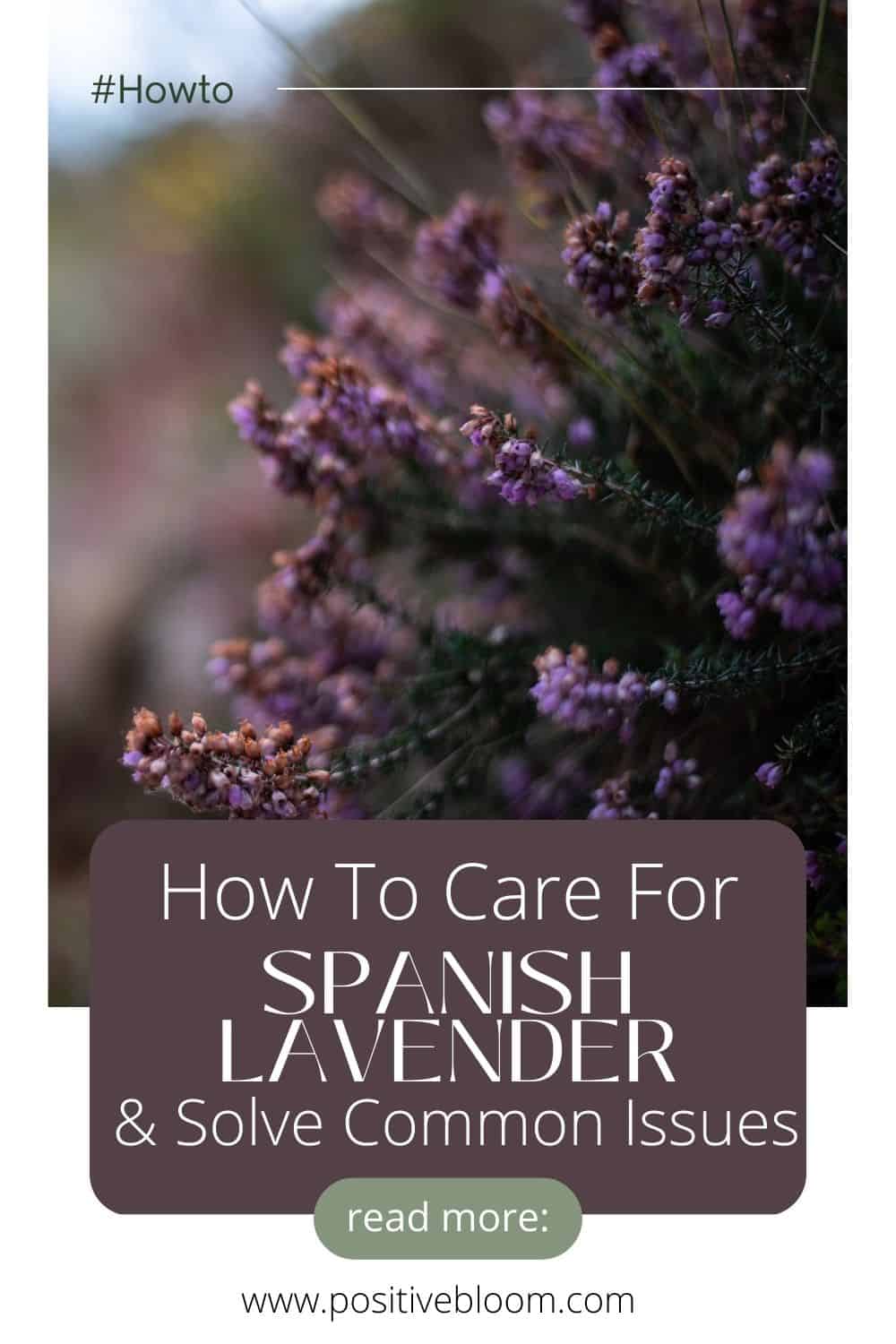Spanish lavender is an evergreen plant that growers sometimes call by its common names, rabbit ears or butterfly lavender, due to its two bracts on the flower heads.
It is a popular species to grow and thrives in warm locations with good drainage. One of the things that we love most about it, is that it comes in purple, pink, or white shades, depending on the cultivar.
In this article, you will find everything you need to know about Spanish lavender plants, from a detailed care guide and common issues you may encounter to some other types it grows well with.
Let’s first look at its basic info:
| Scientific name: | Lavandula stoechas |
| Native habitat: | North Africa and the Mediterranean region, primarily Spain and Portugal |
| Growth rate: | Moderate growth rate |
| Size: | About 2-3 feet tall and wide |
| USDA hardiness zone: | 6-11 |
| Toxicity: | Toxic to pets |
Spanish Lavender Care Guide
This butterfly lavender thrives in full sun locations and moderately fertile soils with excellent drainage, and you don’t have to water or fertilize it too often.
The only thing that requires a bit of care is pruning, and we’ll also discuss that so you can nurture it properly.
Before we get to all that, it is vital to understand the lavender growth stages because young plants and seedlings need much more water than drought-tolerant adult lavender.
Light Requirements
This Mediterranean-native plant needs full sun conditions, so you should plant it in a location that receives at least six hours of direct sunlight a day.
It is best to provide some afternoon shade in areas with scorching summers to protect the plant from the intense midday sun.
Water And Humidity
You should generally water butterfly lavender deeply and infrequently, allowing the soil to dry out slightly between waterings.
During hot, dry weather, it may be necessary to water the plant more frequently to keep the growing medium moist. However, it is essential to avoid overwatering, as this can lead to root rot.
To determine when to water your Spanish lavender, check the soil moisture by sticking your finger about an inch into the soil. If the substrate feels dry at that depth, it is time to water.
When irrigating, be sure to apply the water at the base of the plant and avoid getting the leaves wet, as this can encourage fungal diseases.
Humidity
The optimal humidity level for Spanish lavender is between 30-50%. The plant may be more susceptible to fungal diseases if the humidity is too high. On the other hand, if the air is too dry, the plant may become stressed and not grow as well.
The best way to maintain the appropriate humidity level for Spanish lavender is to put the plant in a well-ventilated area with good air circulation. Avoid placing the plant where it is exposed to drafts or strong winds, as this can dry out the air and stress the plant.
Finally, you can choose this variety if you want to grow lavender in Florida since it can tolerate humidity better than English lavender.
Temperature
Spanish lavender is native to warm climates and prefers daytime temperatures between 70-80°F. It can tolerate temperatures as high as 95°F with proper care.
Spanish lavender is not tolerant of freezing temperatures; frost can damage or kill it. In areas with cold winters, it is best to plant this lavender in a location protected from freezing temperatures, such as a south-facing window or a container you can bring indoors.
It is important to note that Spanish lavender is sensitive to temperature changes and may become stressed if it’s subjected to them, so avoid keeping it near AC vents, heaters, drafty old windows, doors, etc.
Soil And Fertilizer
Spanish lavender grows best in well-draining soil that is slightly alkaline with a pH between 6.5 and 7.5. The soil should also be relatively light and have good aeration.
It is important to avoid heavy clay soils or soils prone to waterlogging, as Spanish lavender is susceptible to root rot if the roots are left standing in water for extended periods.
To prepare the soil for planting Spanish lavender, it is a good idea to mix in a layer of compost to improve the soil structure and add nutrients.
And lastly, add some mulch such as crushed white gravel to protect its root system from harsh winters.
Fertilizer
The best fertilizer for this variety of lavender is a balanced slow-release one specifically formulated for herbs.
(Avoid using high-nitrogen fertilizers, as these can promote leafy growth at the expense of flower spike production.)
Fertilize your Spanish lavender when you plant it and then again in mid-season. Also water your plant after each application, and your lavender will thrive.
Propagation Of Lavandula Stoechas
If you want to make a lavender hedge, but don’t have enough plants, you can simply propagate the ones you have.
You can take a healthy stem cutting, remove the bottom foliage, and plant it in a seed starting mix. Keep them in a humid environment and a sunny location, maintain regular soil moisture, and they’ll soon develop a root system.
You can also divide lavender if it has more than one woody stem. Simply follow the stem and separate the roots with your hand. Plant each lavender in its new pot (one that can fit its root system, but isn’t too large) filled with well-drained soil, and you’re done!
Of course, you can also grow lavender from seeds, and we’ll discuss that in the following paragraph.
How To Grow Spanish Lavender From Seeds
Growing Spanish lavender from seeds can be a rewarding experience, but it does require some patience and attention to detail. Here are the steps to follow:
Step 1. Fill a tray with well-draining compost or a mixture of equal parts perlite and peat moss. Water the soil lightly and then scatter the seeds over the surface. Don’t cover the seeds with the substrate, as they need light to germinate.
Step 2. Place the seed tray or pots in a sunny location and cover them with a sheet of clear plastic to create a mini greenhouse effect. Water the seeds regularly to keep the soil moist, but not soggy.
Step 3. When the seedlings are large enough to handle, transplant them into individual pots or the garden. Choose a sunny location with a well-draining substrate. Plant seedlings at the same depth as they were growing in the seed tray or pots.
Step 4. Water the seedlings regularly, but allow the soil to dry out slightly between waterings to prevent root rot. Fertilize the plants with a balanced slow-release fertilizer according to the manufacturer’s instructions.
Repotting And Transplanting Spanish Lavender
The good news is that lavender doesn’t grow that fast, so you won’t have to repot it too often. However, a similar system applies if you want to transplant them into the ground.
Step 1. Choose a new pot slightly larger than the current one, with drainage holes to prevent waterlogging. Fill the bottom of the pot with a layer of well-draining potting mix.
Step 2. Carefully remove the Spanish lavender plant from its current pot. If the plant is root-bound, gently loosen the roots with your fingers to encourage new growth.
Step 3. Place the plant in the center of the new pot and fill in around the sides with more potting mix, tamping it down gently to secure the plant.
Step 4. Water the plant thoroughly to help it settle into its new pot and moisten the potting mix. Be sure to remove any excess water from the drainage holes to prevent overwatering.
Step 5. Place the pot in a location with full sun, and continue to water and care for your Spanish lavender as you normally would.
Pruning
Pruning lavender is essential if you want it to rebloom, promote new growth, and prevent it from becoming woody. You can even trim it to the desired shape or in a topiary style (don’t worry, lavender tree care is the same as for bush lavender).
Begin pruning in early spring before the Spanish lavender flowers appear. This will allow the plant to focus its energy on new growth.
Cut off any dead or damaged branches or stems.You can also trim lavender to about knee-high or any desired length to help maintain the plant’s shape and encourage new growth.
Prune it again in mid-summer after it has finished flowering to remove any spent flower spikes and encourage new growth.
Here are some more pruning tips:
Overwinter
Spanish lavender is generally hardy in zones 6-11, and if you live in colder climates, you should protect it from the freezing winters.
You can put them inside a garage or shed to keep them safe from the wind, but not in a place that’s so warm they cannot rest over the winter.
And if you just want to keep them warmer in USDA hardiness zones below 8, you can plant your Spanish lavender in a sunny location protected from wind gusts, mulch it, and even cover it with frost cloth or burlap.
Caring for lavender plants is so much fun!
Common Issues With Spanish Lavender Plants
Lavender is a fairly issue-resistant plant, but sometimes it may fall victim to pests, diseases, leaf discolorations, etc.
You can avoid these issues by properly caring for your plants. Still, we understand that these things happen in the garden, so we’ll discuss the solutions below.
Pests
The most common pests that attack lavender are aphids and whiteflies, and you can get rid of them with insecticidal soap or horticultural oil.
However, this fragrant herb is relatively resistant to infestations, and even repels pests and attracts their natural predators.
Diseases
Spanish lavender can easily fall victim to root rot, so if you notice any signs of overwatered lavender, such as yellow leaves, droopiness, slow growth, and a rotting smell coming from the pot, you should immediately treat it.
Take the plant out of the container, expose the roots, and prune any diseased (dark and soggy) parts. You can spray the rest of the roots with a fungicide to prevent the illness from coming back, and repot the plant into a new soil mix.
Leggy Appearance
The cause of legginess is usually lack of sunlight, so make sure to grow this plant in a sunny location where it’ll have at least 6-8 hours of light each day.
Discolored Leaves
If the gray-green leaves start turning yellow, the causes are most likely overwatering (or root rot) and nitrogen deficiency.
Explore each option by checking the soil for moisture (or testing it for nutrients) before treating the plant.
Lack Of Flowers
If your lavender doesn’t produce many dark purple flowers, the primary causes are likely lack of sunlight and too much nitrogen in the soil.
Of course, overwatering and low phosphorus or potassium can also lead to poor flower production, so care for it properly to avoid this issue.
Types Of Lavender Plants
There are many varieties of lavender, whether you want purple or white lavender plants, hardy ones, ones more tolerant of humidity, etc. Lavender is definitely one of the prettiest herbs with purple flowers!
Below, you can learn more about three famous lavender types.
English Lavender
English lavender (Lavandula angustifolia) typically blooms in late spring and early summer, and thrives in USDA hardiness zones 5 through 9.
The most famous cultivars include ‘Munstead’ and ‘Hidcote’. The former blooms in spring and a bit earlier than other varieties.
French Lavender
The cultivars of French lavender (Lavandula dentata) normally flower from late spring to early summer, and their USDA zones range from 8 to 11.
The most popular cultivar is ‘Royal Crown’, which can produce lilac flowers all year long and make a great addition to your herb garden.
The care guide for French lavender is similar to the one for Spanish lavender, so you can grow them side by side in warm climates.
Spanish Lavender
Spanish lavender (Lavandula stoechas) blossoms from mid-spring to late summer, when it can attract beneficial insects such as natural predators and pollinators with its strong fragrance and mesmerizing flower colors.
The most famous cultivars include ‘Ballerina’ (a white lavender plant), ‘Anouk’ (which can come in purple and white variants), and ‘Kew Red’ (adorned with purple-red blossoms).
Final Thoughts
Spanish lavender needs a sunny location, well-draining growing medium, and irregular watering to thrive. You can also fertilize it twice during its growing season, prune it in late winter, and deadhead any flower spikes.
This plant can also suffer from specific issues such as pest infestations and disease infections, discolored foliage, lack of blossoms, and leggy growth. Still, you can prevent them with proper care.
Finally, we briefly presented the most common types of lavenders so that you can choose which will keep your Spanish lavender company.
Until next time!
Like this post? Share or pin it for later!

